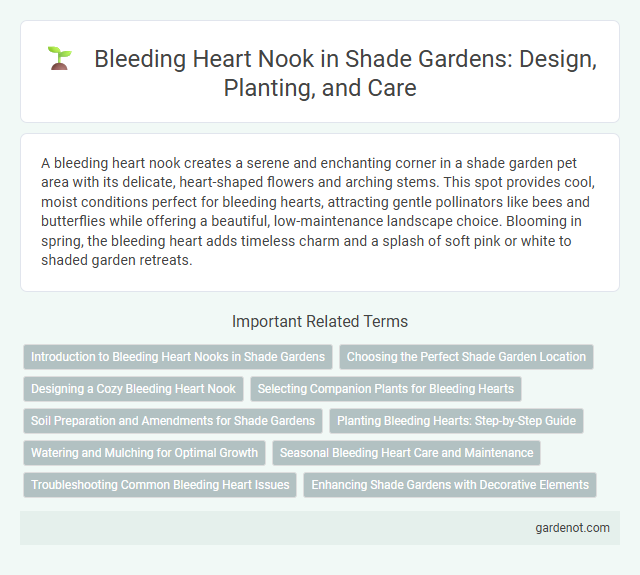A bleeding heart nook creates a serene and enchanting corner in a shade garden pet area with its delicate, heart-shaped flowers and arching stems. This spot provides cool, moist conditions perfect for bleeding hearts, attracting gentle pollinators like bees and butterflies while offering a beautiful, low-maintenance landscape choice. Blooming in spring, the bleeding heart adds timeless charm and a splash of soft pink or white to shaded garden retreats.
Introduction to Bleeding Heart Nooks in Shade Gardens
Bleeding heart nooks in shade gardens create enchanting focal points with their delicate, heart-shaped flowers and arching stems. These shade-loving perennials thrive under trees and in cool, moist soil, providing vibrant pink or white blooms in spring. Incorporating bleeding heart plants enhances biodiversity and adds a graceful, romantic touch to shaded garden areas.
Choosing the Perfect Shade Garden Location
Selecting the perfect shade garden location for a bleeding heart nook requires identifying areas with dappled sunlight or consistent morning shade to mimic its natural woodland habitat. Ensure the soil is well-drained, rich in organic matter, and retains moisture to support the plant's delicate root system. Positioning your bleeding heart under deciduous trees allows it to thrive as sunlight filters through leaves during spring and early summer, enhancing its vibrant blooms.
Designing a Cozy Bleeding Heart Nook
Creating a cozy bleeding heart nook involves selecting a shaded area with rich, well-drained soil to enhance the plant's vibrant pink or white heart-shaped blooms. Incorporate companion plants like ferns and hostas to provide texture contrast and maintain moisture. Positioning the nook near a garden bench or pathway maximizes its visual and tranquil appeal in shaded garden spaces.
Selecting Companion Plants for Bleeding Hearts
Selecting companion plants for Bleeding Hearts involves choosing shade-tolerant species that thrive in moist, well-drained soil. Ferns, hostas, and astilbes complement the delicate, arching blooms while enhancing texture and color contrast in a shade garden. Incorporating plants with similar water and light requirements ensures a harmonious and healthy Bleeding Heart nook.
Soil Preparation and Amendments for Shade Gardens
Loamy, well-draining soil enriched with organic matter is essential for a thriving Bleeding Heart nook in shade gardens. Incorporate compost, leaf mold, or aged manure to improve soil fertility and moisture retention while maintaining a slightly acidic to neutral pH between 6.0 and 7.0. Regularly mulching with natural materials like shredded bark aids in temperature regulation and reduces weed competition, promoting healthy root development.
Planting Bleeding Hearts: Step-by-Step Guide
Planting Bleeding Hearts involves selecting a shaded, well-drained area with rich, moist soil to mimic their natural woodland habitat. Begin by digging a hole twice the width of the root ball, place the plant at the same depth it grew in its pot, and backfill with soil while gently firming around the roots. Water thoroughly after planting and mulch to retain moisture, ensuring consistent hydration during their growing season for vibrant blooms and healthy foliage.
Watering and Mulching for Optimal Growth
Bleeding hearts thrive in consistently moist, well-drained soil, requiring regular watering to prevent drought stress, especially during dry spells. Applying a 2-3 inch layer of organic mulch, such as shredded bark or compost, retains soil moisture, regulates temperature, and suppresses weeds. Proper watering combined with mulching promotes vigorous growth and abundant, vibrant blooms in shaded garden areas.
Seasonal Bleeding Heart Care and Maintenance
Bleeding hearts (Dicentra spectabilis) thrive in shaded garden nooks with rich, well-draining soil and consistent moisture, especially during their active growing season in spring and early summer. Regular watering and mulching help maintain soil moisture, while removing spent flowers encourages prolonged blooming and prevents seed formation. After the foliage yellows and dies back in late summer, cutting it down allows the plant to enter dormancy, requiring minimal care until the following spring.
Troubleshooting Common Bleeding Heart Issues
Yellowing leaves and wilting in bleeding hearts often indicate overwatering or poor drainage, which can lead to root rot. Powdery mildew and rust are typical fungal diseases caused by excessive humidity and inadequate air circulation, requiring prompt treatment with fungicides and improved garden hygiene. Pests such as aphids and slugs can damage bleeding hearts, so regularly inspecting foliage and using organic pest controls helps maintain plant health in shade garden settings.
Enhancing Shade Gardens with Decorative Elements
Incorporating a Bleeding Heart nook into shade gardens introduces a striking visual focal point with its arching stems and delicate, heart-shaped flowers in vibrant pink or white hues. This perennial thrives in low-light conditions, offering seasonal interest from spring to early summer while complementing ferns and hostas commonly found in shaded landscapes. Strategically placing garden ornaments like rustic benches or lanterns near Bleeding Heart clusters amplifies the decorative appeal, creating a serene retreat that highlights the garden's lush, shadowed environment.
Bleeding heart nook Infographic

 gardenot.com
gardenot.com